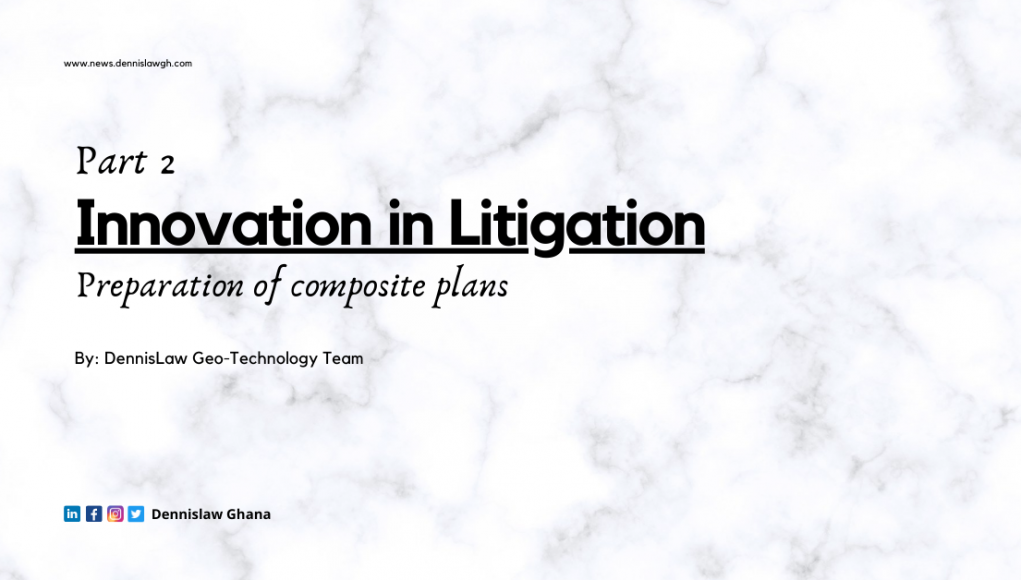Part 2: Innovation in Litigation: Preparation of composite plans in land litigation
During trial, the court is faced incessantly with instances where the parties present site plans with inaccuracies and differences which does not depict the true state of affairs on the ground.

We continue our discussion on how to introduce modern technology in land litigation disputes by discussing the opportunities for technology in preparing composite plans. Read part 1 of the series here
Introduction
Site and Composite plans form a greater part of land litigation and even now, has been made an indispensable part of litigation. In a practice direction dated the 21st day of February, 2018 titled RE: 5- member task force to study proposal by Lands Commission Lawyer Mrs Joyce Attah Gyamfi, the Chief Justice specifically directed all high court and circuit court judges in a land litigation to specifically order for site plans and composite plans at the directions stage. The registrars are to subsequently ensure the copy of the judgment in the case and the site plan are sent to the Lands Commission. This task placed on judges and registrars by the Chief Justice required that accuracy and ease of understanding the plans becoming the order of the day.
Dealing with inaccuracies in site plans
During trial, the court is faced incessantly with instances where the parties present site plans with inaccuracies and differences which does not depict the true state of affairs on the ground. In the case of Ernest Eklu Mensah vs. Paul Kofi Peprah[1] for instance it was observed from the record that the site plans filed in the case had differences. The site plan as filed by the grantors were patently different thus each party had forced themselves to describe their lands to fit the site plans their grantors provided. The trial judge in the case found as a fact thus- “It has further been found as a fact that the composite plan indicated that the land as shown to the Surveyor by the Defendant conforms to the site plan attached to his land title certificate but does not conform to the site plan given by the Nii Owoo family, his grantor. It came out clearly that the land granted to the Defendant was different from that of the Plaintiff. However, the Defendant fraudulently obtained his own site plan to cover the land of the Plaintiff to obtain a land certificate. “
Further inconsistencies are seen in the case of Madam Comfort Ofeibea Dodoo Vs Nii Okai Dorwoso Lokko[2] where on appeal the following were stated-
“What then is the evidence? The Trial Court had observed that the Appellant per her predecessors in title of interest had misled the officials of the Land Registry by stating in the application for registration a land size of 367.820 acres in area. (See Site plan at page 453 of Vol.2 of the record site plan in the name of Comfort Offeibea Dodoo). Strangely however, the size of the land described in the Statutory Declaration/Affidavit Exhibit ‘11’ is 229.67 acres and both are supposed to form part of one document to give effect to the registration (page 450 of the record). It was this inconsistency in excess of 138 acres which the Trial Court found as a gigantic misrepresentation of facts intentionally made to mislead the officials of the Land Registry to claim additional land not owned by the Appellant and her predecessors and thereby perpetuated fraud as the Appellant could not prove the claim to the 229.67 acres. To mitigate the apparent inconsistency, the Appellant submitted that the finding of fraud by the Trial Court upon consideration of Exhibit 10 made in 1979 was the result of the conduct of staff of the Department of Surveys at the time. The Appellant contended that the use of the Global Positioning System (GPS) instrument in the 1990”s gave the land size a larger representation as against that of the 1970’s which gave different approximates of the size of the land. The Appellant referred to page 354 of the record where it alleged that it was due to the equipment used. The Trial Court did not accept the Appellant’s explanation of the significant difference in the land size contained in the two documents. At pages 111 and 112 of Vol.2 of the record, the Trial Court placed on record as follows: – “In the instant case I am satisfied that Mercy Naa Amponsah aka Mrs Mercy Dodoo had full knowledge of the apparent fraud in the registration of the land as No.1582/1979 and stamped as ER.257/79 in her favour by the land title Registry at Koforidua. I am satisfied that Mercy Maa Amponsah aka Dodoo had personally caused the fraud by attaching to the declaration a site plan of land much larger that the land declared and sworn to in her Statutory Declaration – Exhibit ‘10’. I am further satisfied that Comfort Ofeibea Dodoo equally had knowledge or ought to have known of the fraud committed by her mother -,Mercy Amponsah in increasing the size of the land by enabling that larger land to be registered in her (Mercy Amponsah) name. I am again satisfied that Comfort Ofeibea Dodoo also subsequently contributed to the perpetration of the fraud committed by her mother, when she (Comfort Ofeibea Dodoo) also applied for the Land Title Certificate in respect of a much larger land than that subject matter of her mother (Mercy Amponsah) Statutory Declaration”.
This phenomenon which is rather common in land litigation has been a tool to perpetrate fraud especially since the parties can fraudulently hire a person in drafting such plans and manipulate the land administration system. The reason it still persists is that until the other parties also draws up their site plan and lead evidence to that effect, there may be little or close to no means of ascertaining the veracity of same since there is no ascertainable objective standard. It is not an undeniable fact that today many of the lands are still claimed and described by the use of traditional evidence wherein the court is then forced to apply the rules on traditional evidence in making its determination. The probability of the court in reaching a conclusion with such form of evidence often sparks more controversy than it started with. This makes reason for the use of technology to standardize the mappings and land administration in Ghana so as to reduce the incidence of fraud and misconceived plans.
How technology deals with this
The typical site plan can be described as drawing of lines which shows the size of the land with its bearings in terms of longitude and latitudes which is the gridlines. The court cannot ascertain the true nature of the land by just having a look at the site plans of the parties. Technology now allows one to ascertain the grid lines showing the latitudes and longitudes as well as seeing the current nature of the land.
With the use of GIS technology the site plans of the parties can be superimposed with ease using their longitude and latitudes whiles still showing the current nature or state of the land.
Drones
It is worth mentioning that in other jurisdictions, inspections, mapping, plotting and even surveying is done with ease with the use of drones. Across the globe, the use of drones have become popular in public spaces. In an article published in the Fordham Urban Law Journal titled Warrantless Operations of Public Use Drones: Considerations for Government Agencies[3] the authors argue that In the United States of America for instance in California to be precise, drones have been adapted to be used in assisting search and rescue efforts and to deliver such aerial imagery to law enforcement during criminal pursuits. This adaptation further extends to other watches of legal procedures.
Drones are equipped for its performance with a state of the art technology such as infrared technology, GPS and lasers with sensors and navigational systems. They have an inbuilt software algorithm and SLAM technology which enables them to produce images into 3D maps as well sense and avoid obstacles in their path. With the use of a Marilyn VTOL (Vertical Take-off and Landing) drones can be used to easily map sites and places even under adverse weather conditions. [See: https://www.dronezon.com/learn-about-drones-quadcopters/what-is-drone-technology-or-how-does-drone-technology-work/]
Suffice to say that the drone technology isn’t alien to Ghanaian since same has been adopted in the health sector to deliver drugs across towns of which this form of technology has proven to be effective in emergent times.
In view of the points mentioned above a simple Google Earth Digital image of the Law Court Complex has been captured with a drone to show all the grid lines of the court by a click of a button. The second picture below clearly show the state of the Law Court Complex together with all the relevant grid lines. With digital pictures, the court will be in a position to ask more relevant questions as it stands to really see the nature of the dispute between the parties. The professional GIS expert can with ease use this technology in the court room to assist the court. A composite plan with a superimposition of the various site plans of the parties together with their lands that they have shown on the land would be ascertained easily. The era of reliance on grid lines alone is over and there is a call for the court to embrace digital composite maps which show the current state of the land in dispute.

Further evidence in history
It is important to mention that the use of GIS technologies in land or territorial dispute settlement dates as far as 1995 and consequently is not new to the court. In the 1995 Dayton accord case, which saw the US in Ohio bring together two antagonistic parties; Croatia and Bosnia in the Bosnian civil war in an attempt to bring peace by drawing a boundary between their territories into two autonomous territories. During the negotiation process, virtual terrain was used to locate the digital representation of the territories without actually travelling physically over Bosnia in an aircraft. At the time, paper maps remained popular so digital cartography tools were not in use. Yet, the digital cartographic tool with respect to power scene, satellite imagery, terrain modeling, virtual flyovers were flexible in providing both content and display effortlessly and was less time consuming. It also gave a lot of information and made communication easier by showing multiple layers of spatial information. After further deliberation, the parties were in agreed to the outcome of the cartographic mappings. A boundary proposal was prepared using digital cadastral tool without using the traditional map for the boundary line to be drawn. The negotiations at Dayton offer one of the first instances of GIS tools being used to settle a conflict involving territory.[4]
Conclusion
The use of GIS Technology will ensure that composite plans are drawn with ease and fast manner so as to ensure that there is speedy and effective justice. A composite plan showing digital images will assist all parties and their lawyers to be in a position to easily read and understand the work of the Regional Surveyor who is tasked to submit a composite plan to the court. The work of such plans will become intelligible for the court to read and the days where the court was taken hostage by biased surveyors will be a thing of the past.
[1] [2020]DLCA8842
[2] [2019]DLCA8832
[3] Gregory S. McNeal, William Goodwin, and Sezen Jones,Warrantless Operations of Public Use Drones: Considerations for Government Agencies, 44 Fordham Urb. L.J. 703 (2017).
[4] Jordan Branch, “Territorial Conflict in the Digital Age: Mapping Technologies and Negotiation,” International Studies Quarterly 61, (2017): 557–569


